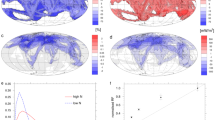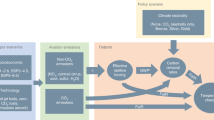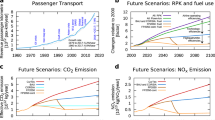Summary
The global distribution of the contrail coverage is computed for several scenarios of aviation in the years 2015 and 2050 and compared to 1992 using meteorological analysis data representative of present temperature and humidity conditions and assuming 0.5% cover in a reference region 30° W–30° E, 35° N–75° N covering parts of western Europe and the North Atlantic. The mean contrail coverage of the Earth is computed to increase by a factor of about three compared to 1992 and to reach 0.25% in 2015. For three different scenarios of aviation and for constant climatic conditions, the global mean contrail coverage reaches values between 0.26% and 0.75% for 2050. Contrail coverage increases more strongly than total fuel burn mainly because of more traffic in the upper troposphere and because of more efficient engines with cooler exhaust. The overall efficiency of propulsion is expected to grow from about 0.3 in the fleet average of 1992, to 0.4 in 2015, and to 0.5 in 2050. The expansion of air traffic makes Canada, Alaska, the North Pacific route from North America to Japan and most of the Asian continent new regions where contrails are expected to cover more than 0.5% on average.
Similar content being viewed by others
Author information
Authors and Affiliations
Additional information
Received September 7, 1998 Revised January 4, 1999
Rights and permissions
About this article
Cite this article
Gierens, K., Sausen, R. & Schumann, U. A Diagnostic Study of the Global Distribution of Contrails Part II: Future Air Traffic Scenarios. Theor Appl Climatol 63, 1–9 (1999). https://doi.org/10.1007/s007040050087
Issue Date:
DOI: https://doi.org/10.1007/s007040050087




